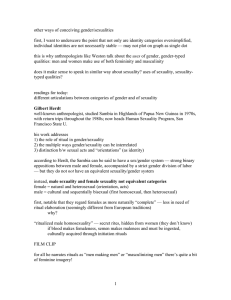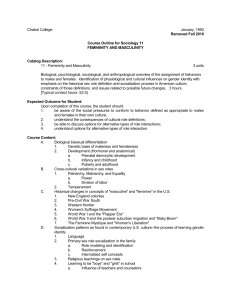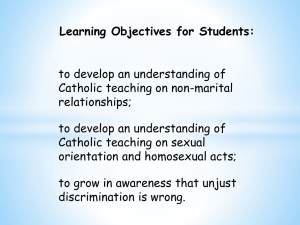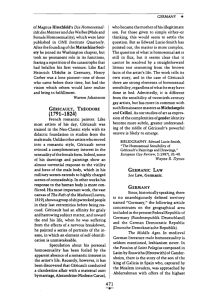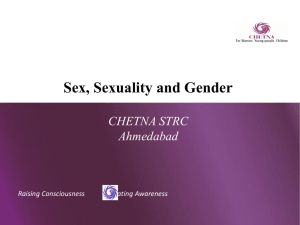Mema’s House an ethnography of contemporary Mexico City
advertisement
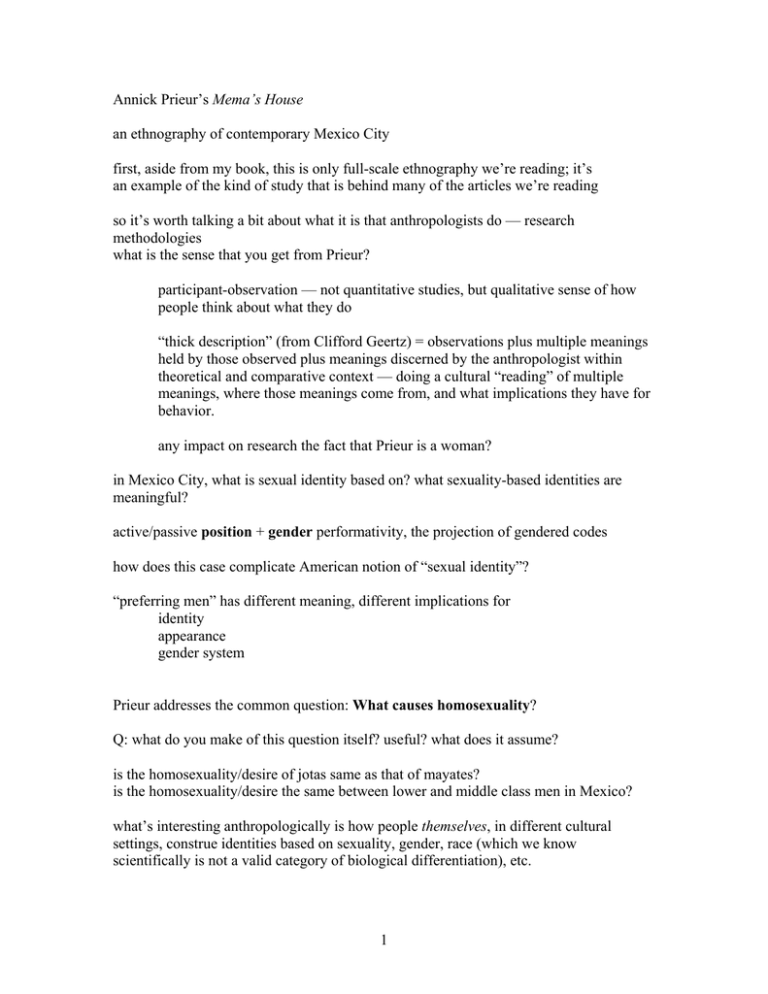
Annick Prieur’s Mema’s House an ethnography of contemporary Mexico City first, aside from my book, this is only full-scale ethnography we’re reading; it’s an example of the kind of study that is behind many of the articles we’re reading so it’s worth talking a bit about what it is that anthropologists do — research methodologies what is the sense that you get from Prieur? participant-observation — not quantitative studies, but qualitative sense of how people think about what they do “thick description” (from Clifford Geertz) = observations plus multiple meanings held by those observed plus meanings discerned by the anthropologist within theoretical and comparative context — doing a cultural “reading” of multiple meanings, where those meanings come from, and what implications they have for behavior. any impact on research the fact that Prieur is a woman? in Mexico City, what is sexual identity based on? what sexuality-based identities are meaningful? active/passive position + gender performativity, the projection of gendered codes how does this case complicate American notion of “sexual identity”? “preferring men” has different meaning, different implications for identity appearance gender system Prieur addresses the common question: What causes homosexuality? Q: what do you make of this question itself? useful? what does it assume? is the homosexuality/desire of jotas same as that of mayates? is the homosexuality/desire the same between lower and middle class men in Mexico? what’s interesting anthropologically is how people themselves, in different cultural settings, construe identities based on sexuality, gender, race (which we know scientifically is not a valid category of biological differentiation), etc. 1 Prieur surmises complex combination of biological, cultural and social factors that crystalize into self-perceptions and identities depending on cultural context Personal Origin Stories — the stories they tell about themselves to explain who they are what is a common narrative among the jotas? innate tendencies — dolls, dressing in mother’s clothes, fascinated by penises early sexual abuse (age 6-8), possibly triggered when adults recognized their “homosexual or feminine tendencies”; discovery: “liked” it how might we understand, interpret this? “patriarchal bargain”? classic patriarchy = law of fathers (manliness often = abuse) see Marta’s story what can we discern about the cultural context in which this story makes sense? ideology that all men are potentially homosexual — indeed, percentage of Mexican men who have sexual experiences with other men is significant, probably well over 50%— notion that if they try passive role they might like it, and then they’d have to come to terms (according to jotas) with this self-realization — tortillas who deny taking passive role are “repressed homosexuals” — jotas are essentializing this identity based on pleasure/practice — not so much a matter of choice or preference, but “born that way” do mayates confirm this? no — more constructivist view — fear that they may learn that they like it (not inevitable) what’s particularly problematic for the mayates about this? why the apparent denial of passive pleasure among the tortillas? homosexual desire (defined as passive) = feminine gender characteristics homosexuality is strongly linked with emasculination, not being a man active bisexuality (penetrating men) not marked as ‘homosexual’ but also is not an open identity — neither accepted nor stigmatized, but hidden not “closeted” because not attached to inner sense of authentic self in Mexico, don’t have (or only among middle classes) machos who prefer sex with men exclusively and claim homosexual identity (gay) — no “popular class” Macho Men, hypermasculine gay men with built physique and cropped hair in Mexico, gender is a stricter binary category than sexuality, whereas the opposite is the case in the US what did you make of the jotas relationships with their families? 2 easier for families to accept homosexual tendencies than feminine presentation — WHY? we’ve been talking about gender — what it means to be proper man/woman, what’s read as masculinity/femininity — but what about patriarchy? male domination (as Prieur says)? by being improper men in displaying passive femininity, reinforces idea that proper masculinity is active, aggressive, dominant — exception proves the rule in reducing femininity to sexual passivity, ideology perpetuates male dominant view of proper womanhood; but this is reductive, fictional — women’s subjectivities are not reduced to passive sexuality however much jotas make of their feminine gender identity, Annick Prieur demonstrates through ethnographic observation that their gendering is more complicated than their own depictions suggest — HOW? they’re not women (can lead to health problems, violence, disillusionment) they’re not entirely not masculine — examples of how they operate in the world in ways that are coded masculine? physical toughness, fist fights competitiveness (whose breasts bigger, better, etc.) what does femininity boil down to for them? passive role in sex, ability to attract manly men — exaggerated feminine appearance — not just feminine signs, but feminine signs of sexual availability — far from a feminist understanding! embrace certain aspects of feminine suffering — for beauty, if not for children physical fighting, masculine competitiveness, messiness • gender is not straightforward matter of personal “choice” (class makes a difference) • vestitas, in fetishizing or parodying feminine sexuality, can be seen more to reinforce dominant gender stereotypes (dualistic model) than to challenge them 3 MIT OpenCourseWare http://ocw.mit.edu 21A.231J / WGS.455J Identity and Difference Spring 2006 For information about citing these materials or our Terms of Use, visit: http://ocw.mit.edu/terms.
